|
An early
Guide Book
| In 1884, John Steen & Company Limited
published the second edition of the
Wolverhampton Guide. One of the first
guidebooks dedicated to the town.
The text
below and some of the illustrations are from
the book, which includes a brief history,
details about religious institutions, local
industries and general information.
Copies now are quite scarce. |
 |
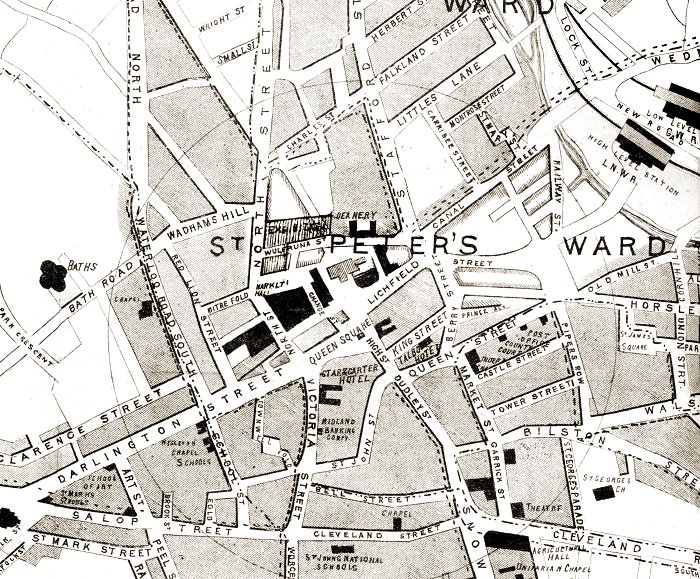
Part of Steen's 1884 map of Wolverhampton.
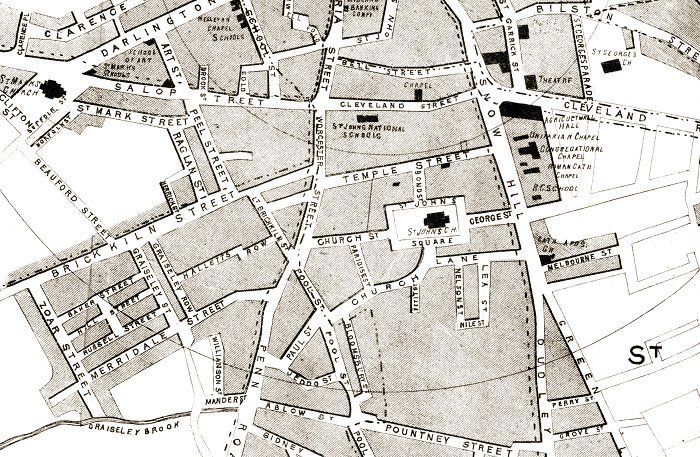
Another part of Steen's 1884
map of Wolverhampton.
|
The new Town Hall is
situated in North Street, occupying the same
spot on which the Red Lion Hotel stood for
many years, a famous posting house in its
day, and remembered by many of the old
inhabitants for its connection with the mail
and other coaches, running between
Shrewsbury and London, the principal of
which made this hotel the place of call on
their daily route to the metropolis.
The Town Hall has been
built from the designs of Mr. E. Bates,
Manchester, architect, by Mr. P. Horsman, of
Wolverhampton. The style of architecture of
the facade is Italian, with a Mansard roof.
The building contains, on the ground floor,
the entrance hall and vestibule, sessions
and magistrates' courts, and various offices
in connection therewith; also council
chamber and municipal offices; waterworks
and poor rate offices. The second floor
contains committee rooms, mayor's parlour,
and recorder's rooms. In the basement are
prisoners' cells, and in the courtyard at
the rear, and extending to Red Lion Street,
are the Health Office and barracks and
offices for the police, together with fire
engine house. The total cost of the
buildings was about £19,000.

The Town Hall. |
|
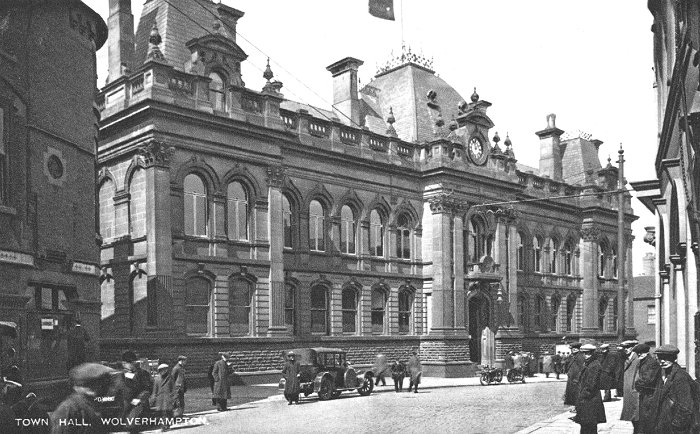
From an old postcard. |
| The Corporation Baths are situated in
Bath Road, out of Waterloo Road South, and
are very complete with plunge and private
baths. Friday is the day reserved for ladies
to use the swimming bath. The terms are most
moderate. And at a short distance, between
the Park and Darlington Street, are Turkish
Baths, established by private enterprise.
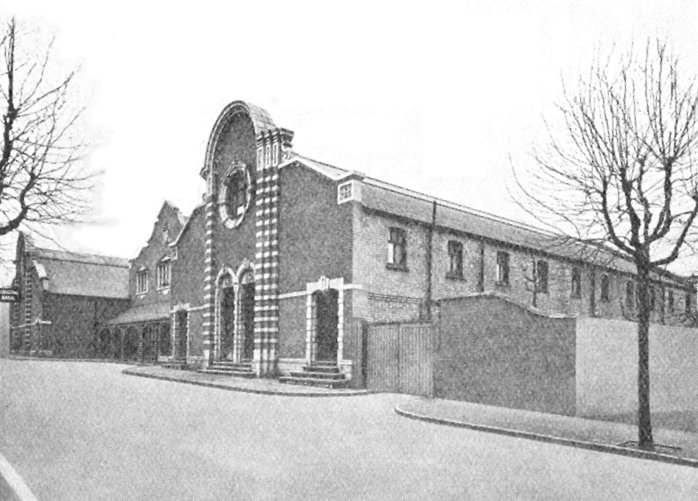
The Municipal Baths in
Bath Road that opened on the 4th November,
1909. |
| The Exchange was erected in the year
1851, at a cost of £15,000, raised by
shares. The position, on the west side
of St. Peter's church, is an unfortunate
one, as it sadly interferes with the
effect of that beautiful building. It
was first intended simply as a Corn
Exchange, where farmers and millers
could congregate on market days, without
being exposed to the inclemency of the
weather, to which they had been subject
from time immemorial in their weekly
gatherings opposite to the shop of
Messrs. Steen and Company, in Queen
Square. |
|
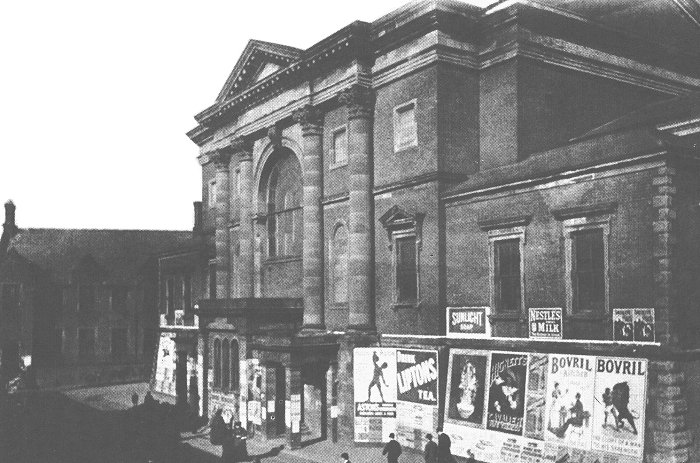
The Exchange. |
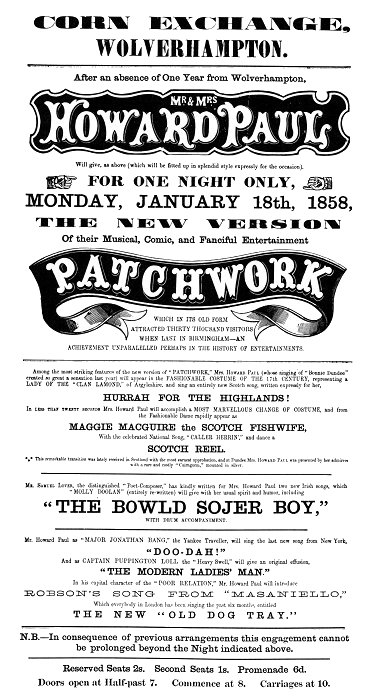 |
The building was
erected from the design of Mr. Robinson,
architect, and had originally a large glass
cupola, which, however, having given
undeniable signs of depression, was
eventually removed. The room is 120 feet
long by 50 feet wide, and a capacious
gallery has been added. The two portraits
which adorn the wall are those of the first
mayor, the late. G. B. Thorneycroft, Esq.,
and the late T. W. Giffard, Esq., the
popular "Squire" of Chillington. Both were painted by public
subscription.
The light for showing
samples of wheat not being considered
sufficient by the farmers, and from
other causes, an Agricultural Hall was
built by shares, and after a long
divided opinion upon the merits of the
two buildings, the corn market
eventually ceased altogether to be held
in these rooms, which are now devoted to
the iron masters' meetings, and the
holding of public and religious
meetings, balls, concerts, etc., for
which purpose they are peculiarly
adapted.
A theatrical license has been
granted to the proprietor, and the necessary
scenery, etc., for operatic and theatrical
performances has been added.
The meetings of
the South Midland Institute of Mining,
Civil, and Mechanical Engineers are held in
these rooms. The basement of the Exchange is
used as offices and stores by ale and wine
merchants, etc. |
|
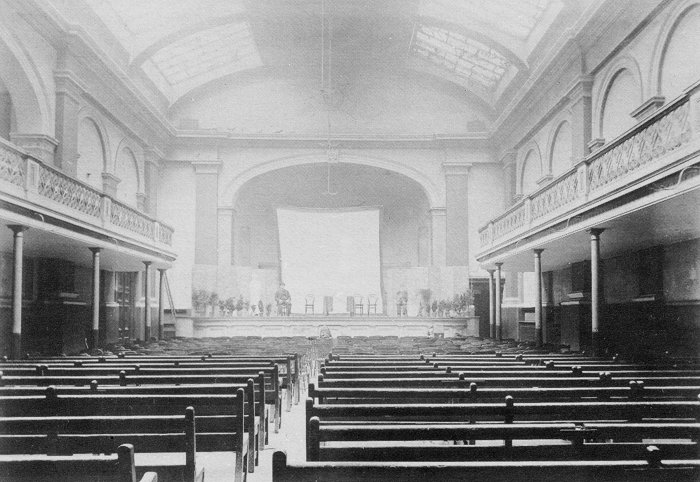
The interior of
the Exchange. |
|
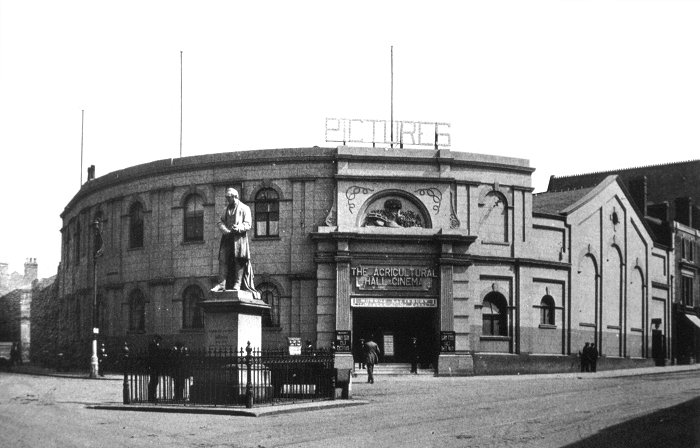
The
Agricultural Hall when it was a
cinema. From an old postcard. |
| The Market Hall is a
capacious building, and may be called a twin
sister to the Exchange, as it was built at
the same time and by the same means as its
more aspiring neighbour. The weekly market
was formerly held in the open market place
(now Queen Square), and was long a nuisance
to the inhabitants and a great trial to the
health of the butchers, greengrocers, etc.,
who possessed its stalls. It presents a busy
scene, indeed, on Wednesdays and Saturdays,
especially on the evenings of the latter
day, and is well worth a visit at those
times, affording an interesting specimen of
the market doings of the working classes on
receipt of their weekly wages. The market is
fitted up with every convenience, and has an
abundant supply of good water, the stalls
are let at very moderate rentals, and the
market house is a great boon, equally to the
buyer and seller. |
|
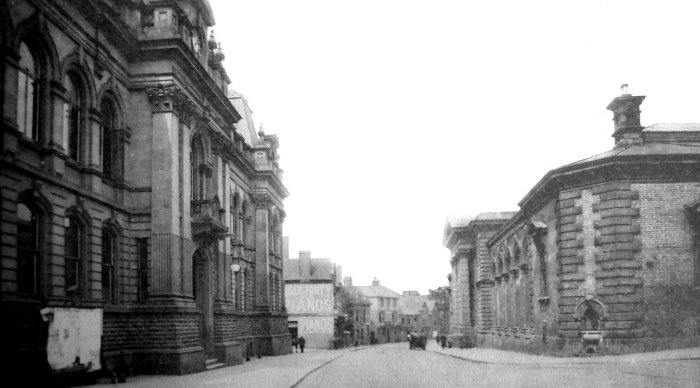
The Town Hall and
the Market Hall. From an old postcard. |
|

The market hall
and Cheapside. From an old postcard. |
|

From an old
postcard. |
|
The Free Library in
Garrick Street, was opened to the public on
the 30th of September, 1869. The news room
is well supplied with London and provincial
papers, and the library room with
illustrated newspapers, and a number of
popular, literary, and scientific
periodicals and magazines. The news room is
open daily, from 9 am. until 10 pm. Library
hours are from 10 am. until 9 pm. On Fridays
no books are issued, but the reading rooms
are open as on other days. Attendance of
readers, daily, about 1,000.
The lending library
contains upwards of 21,000 volumes, and more
than 44,000 applications were entered from
borrowers, of all trades and professions, in
the year 1883. The reference library
(available to any person over 14 years of
age, on filling up a form, supplied by the
Librarian) contains upwards of 3,800
volumes. The "Times" and "Wolverhampton
Chronicle" are filed in the reference
library. The rules of the institution, and
catalogues of the books, may be seen at the
library. Recently a commodious Lecture Hall,
calculated to seat 650 persons, has been
added to the Free Library; and in this free
lectures are delivered every Saturday
evening during the winter. Many science and
language classes are held in connection with
the library, and altogether, it is a centre
of considerable intellectual life in the
town. The whole is under the management of a
Committee appointed by the Town Council.
|
|
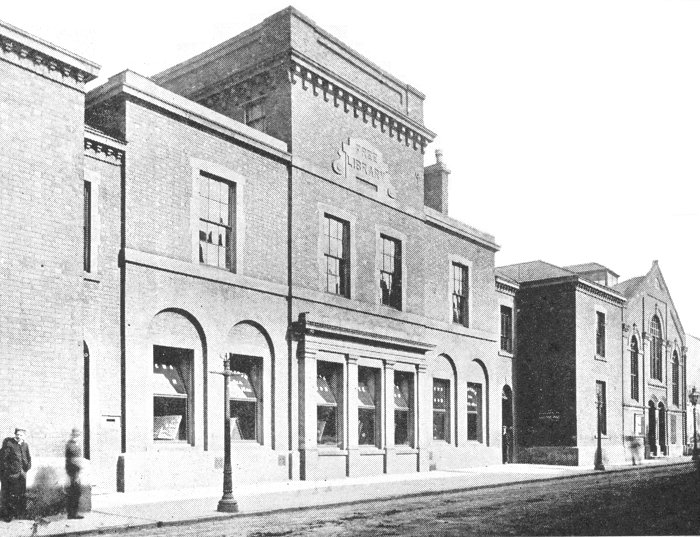
The Free Library
in Garrick Street. |
| The Town Library in
Waterloo Road South, was formerly located in
Queen Street, in the building now occupied
by the County Court. The present commodious
and elegant rooms were built from a design
of the late Mr. Banks, architect, in the
year 1857. The library is, we believe, the
oldest institution in the town, except the
Blue Coat Charity School, being founded so
long ago as 1794. It possesses about 14,000
volumes, of every description of literature.
Most of the new books of repute are received
as soon as published, and all the leading
periodicals are taken. An excellent reading
room is attached. Subscription, 24s. per
annum. Open from 10 to 5. |
|

The Town Library
in Waterloo Road. |
| The Cattle Market in
Cleveland Road, is a very capacious and
convenient erection for the weekly sale of
horses and cattle and is, we believe, one of
the largest and best attended of any in the
kingdom. The number of cattle sold here is
prodigious, the average weekly sale being as
follows: horses and ponies, 220; beasts,
550; sheep and lambs, 3,000; pigs, 1,500;
and calves, 900 weekly for three months in
the year. |
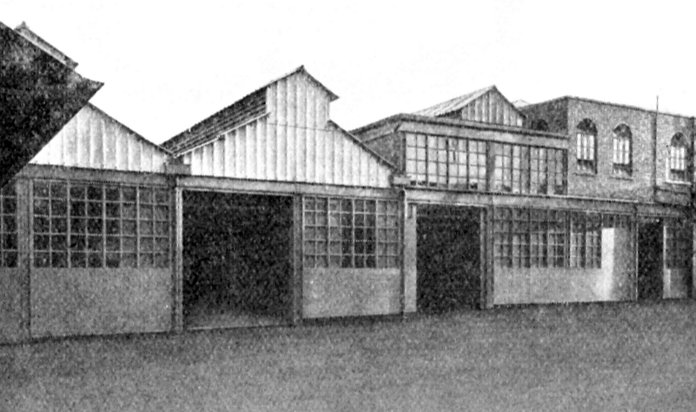
The Municipal
Abattoir, covering a little over one and
a half acres and costing just over
£72,000, opened on part of the cattle
market in 1929. |
| The Theatre Royal
occupies a position not far from the
Agricultural Hall, on Cleveland Road. The
present building was erected in 1844. The
proprietorship is now converted into a Joint
Stock Company Limited. Many good companies
from London from time to time come down, and
really good performances may be witnessed
here. We should mention that Mr. Sothern
(better known as Lord Dundreary) made his
first appearance on the stage here. The
theatre originally was at the top of the
Swan Hotel yard, in Queen Square, and was
built in 1779. It was in this theatre, we
believe, that the celebrated tragedian John
Kemble made his debut, in the character of
"Theodosius," and here, too, his not less
celebrated sister, Mrs. Siddons, frequently
performed. The former was educated at
Sedgley Park (Roman Catholic) Seminary,
about two miles from Wolverhampton. Farren,
too, the eminent comedian, also made his
debut on the boards of this theatre, which
is now pulled down, and the space occupied
by carriage houses, at the back of Lloyds
Bank in Queen Square. |
|

The Theatre Royal. |
|
The Art Gallery was
first announced to the council in the autumn
of 1882 by the Mayor, Alderman John Jones,
who stated that a Townsman, who desired his
name to remain unknown, was willing to place
the sum of £5,000 in the hands of himself,
Sir Rupert Kettle, and the Rector, as
trustees, to erect an Art Gallery for the
town, providing the Corporation would assign
land for the purpose. This met with a
unanimous response from the Council. After
much deliberation and discussion, the
trustees selected the plans of Mr. J. A.
Chatwin, architect, of Birmingham. From
these the present building was erected in
1883-84.
The building is in the
Palladian style. Omitting the basement, it
consists of two storeys, one pierced with
curved-headed windows with plate glass, and
the other, containing the picture gallery,
lighted by sky-lights so as to throw down
the light upon the pictures. This upper
storey necessarily has un-pierced walls for
the pictures to hang upon, but its otherwise
blank aspect outside is most creditably
relieved by the insertion of some sculptured
panels executed by Mr. Carter, from the firm
of Messrs. Boulton of Cheltenham, sculptors,
and representing Sculpture and Painting, on
the right and left hand of the handsome
portico in Lichfield Street, and various
Sciences on the long panel facing St.
Peter's Close.
These enrichments, and
the granite pillars of the Lichfield Street
front, were the additional gift of the
tasteful donor. When the new School of Art,
now in course of erection, is completed, the
whole will have the beauty which arises from
symmetry and proportion; though we ourselves
are not alone in thinking that a classical
building is altogether out of place in such
immediate juxtaposition to the old Gothic
Collegiate Church, and the Wolverhampton and
Staffordshire Bank, and the Poor Law
Offices, which, if not Gothic, have no
classic character whatever. The corner
facing Queen's Square is tame, and the
sky-lights, with their ventilators,
appearing above the balustrade and roof
running at right angles to the Lichfield
Street gable, instead of dying into it, are
unpleasing. |
|
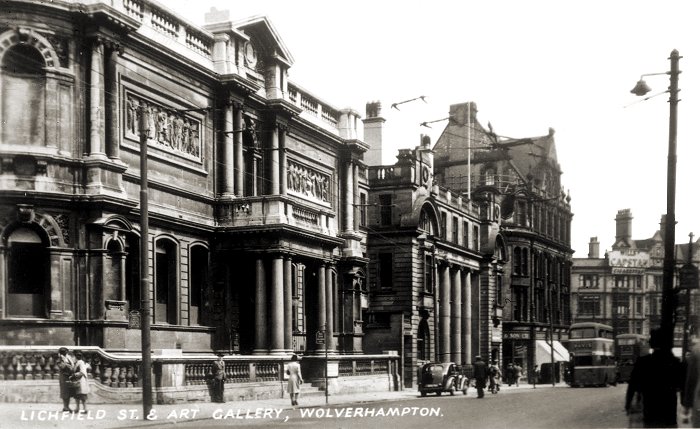
From an old
postcard. |
|
Entering through the
Lichfield Street portico, we find that it
consists of three floors; the basement
containing curator's apartments, cloak room,
heating apparatus, and one long handsome
room which could be devoted on occasions to
sculpture or the like; the ground floor
containing office and cloak room to right
and left of the entrance into the handsome
Hall with its staircase of easy gradient.
Out of the Hall we enter, on the left hand,
into a fine room overlooking St. Peter's
Close, and proceeding through the smaller
north room, come into a similar fine room,
though lighted from the two ends, and so
back again into the entrance Hall. This
floor is intended for the Art Museum.
Going upstairs we find
a similar arrangement of four rooms round a
square entering one into the other, all of
them beautifully lighted from the top and
designed for the reception of pictures, some
few of which have already been presented to
the town by various donors. The whole, when
dedicated to the public, will be the
property of the Corporation, and in charge
of the Free Library Committee. Sufficient
praise cannot well be given to our townsman
(whom we are permitted to name as Mr. Philip
Horsman), for his spirited liberality in
thus seeking to raise the art-tone of his
fellow-townsmen; which we trust will be met
by a response on their parts which will lift
many of our commonplace manufactures into
the category of artistic ware; besides
producing from time to time artists (like E.
Bird, R.A., a native of this town) who may
achieve, an English reputation.
|
|
The Drill
Hall
The Drill Hall is the
headquarters of the 3rd Volunteer Battalion
of the South Staffordshire Regiment, which
is one of the largest in the kingdom,
numbering, on the 31st October 1883: 1,190
efficients, and a total of 1,195.
Until recently, and for
the last fifteen years, the Battalion has
been commanded by Lieutenant Colonel
Commandant John N. Bagnall, of The Moss,
Shenstone. The present Commandant is
Lieutenant Colonel Foster Gough, assisted by
Lieutenant Colonel George Singleton Tudor.
The Adjutant is Major W. Blake Burke. For a
number of years the headquarters of the
Battalion has been at the Agricultural Hall,
but from various causes it was found
necessary to make an attempt to obtain
headquarters belonging solely to the
Battalion, and adapted to the requirements
of the present time, and a suitable site has
been purchased, with a frontage to Stafford
Street, Thornley Street, and Whitmore
Street; and if the public support the
movement sufficiently, a Drill Hall and
necessary offices will soon be erected on
that site.
The Battalion consists
of twelve companies, six of which belong to
Wolverhampton, one to Tettenhall, and the
other five are from Tipton, Bilston,
Sedgley, Willenhall, and Darlaston.
|
|
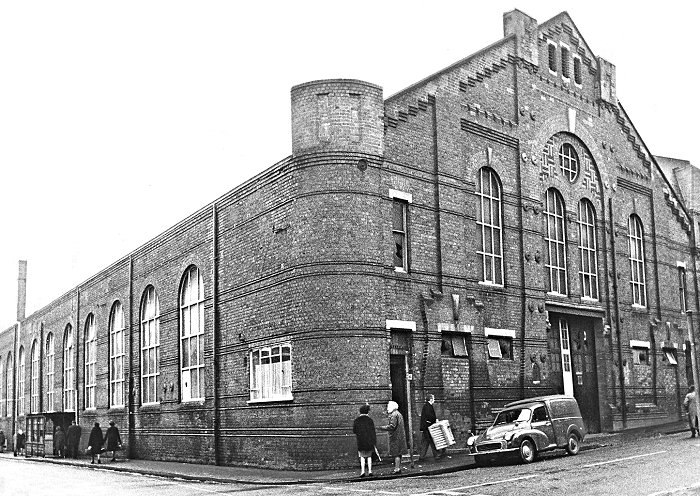
The Drill Hall on
the corner of Thornley Street, and
Whitmore Street. From an old newspaper
cutting. |
|
Local
Newspapers
The Wolverhampton
Chronicle, which is the oldest established
paper in Staffordshire, having been first
issued in 1789, is published weekly, on
Wednesday; the Midland Counties' Express,
which was originated in 1861, is published
at the same office, in Market Street, on
Saturday morning. Both these papers have
very large and influential circulations in
the district. The Evening Express was
started upon the foundation of these two
weeklies in 1874, and rapidly attained a
position amongst the Daily Press of the
country through the excellence of its news
supplies. The Evening Star, daily, price one
halfpenny, has the largest circulation of
any Liberal paper in the Midlands, and
contains the fullest, the latest, and most
reliable home, foreign, local, and sporting
intelligence.
The Midland Counties'
Guardian, published every Saturday morning,
contains the local, district, and general
news of the week. Office, Horseley Fields.
The Midland Evening News (24 columns),
daily, one halfpenny, with which is
published The Midland Weekly News (48
columns) on Saturday, 1d. A special late
edition of the daily paper on Tuesday
evening is also published, for the
agricultural and other readers, containing
all the latest market news. The above are
published by "The Midland Press Limited;"
offices, 33 Queen Street, Wolverhampton.
Capital £30,000 in 30,000 shares. This
Company was formed under circumstances of a
very special and interesting character.
On the 23rd February,
1884, it was found that The Wolverhampton
Chronicle, The Midland Counties Express, and
The Evening Express; three papers which,
though nominally independent in politics,
had for some years been recognised as
supporting moderate Conservative views, had
been unexpectedly sold in February to "The
Midland News Association, Limited," under
whose auspices newspapers devoted to the
political interests of the Radical Party
have been published in various parts of the
country, and it was resolved that a Company
should be formed for the purpose of
publishing a Daily Evening, and such other
papers as might be decided upon, to supply
the place of those which had been so
abruptly severed from their old
associations.
The Chairman is The
Right Hon. the Earl of Dartmouth, the Vice
Chairman is Alfred Hickman, Esq. and the
Secretary and General Manager is Mr. J. Ridd
Hayman, 33 Queen Street. The papers
circulate not only in Wolverhampton and the
immediate districts, but throughout a great
part of Staffordshire, East Worcestershire,
Shropshire and Warwickshire. The prospectus
of the Company, describing the politics of
the new paper, states "they will be
conducted in" accordance with those sound,
moderate, Conservative " principles which
are every day finding more and more favour
with thoughtful men and women of all
classes," and especially with those whose
interest in the stability of our
institutions, and the security of property
of every kind, constitutes them the natural
readers and supporters of a moderate
Conservative press, and who form, more than
any others, those to whom advertisers can
usefully appeal.
The Staffordshire
Advertiser is published on Saturdays, price
3d. Wolverhampton Agents, Messrs. John Steen
and Company, Printers and Stationers, Queen
Square, where advertisements are received.
Public Transport
The London and North
Western Railway Station and Offices, with
those of the Midland Railway, are situated
at the bottom of Lichfield Street. The Great
Western Railway has its extensive station
and offices not far from the bottom of Canal
Street, about 200 yards from the London and
North Western. By these lines, easy access
is had to all parts of Great Britain. The
express trains convey passengers to the
Metropolis in about 3½ hours.
An omnibus runs from
Queen Square, Wolverhampton, to Penn, and
vice versa, five times a day.
Omnibuses also ply to
both Railway Stations from the Star and
Garter Hotel, and the Peacock Hotel. Tram
lines are laid to Tettenhall, Bilston, and
Willenhall, and the trams run usually every
quarter of an hour; also to Sedgley, though
the service is not so frequent.
Cabs and cab stands
|
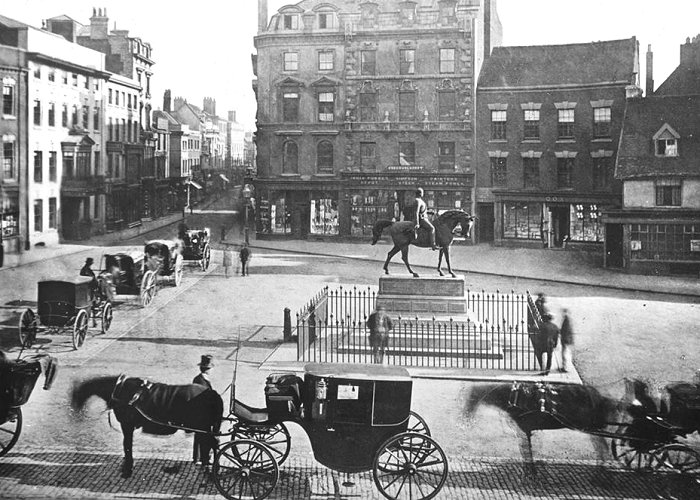
Cabs in Queen
Square. Cab stands were a common sight
in the 19th century. Although a popular
form of transport, cabs were only used
by the wealthier members of society.
Most ordinary people could not afford to
use them. |
|
It is scarcely twenty
years since an ineffectual attempt was made
to establish a cab stand in Queen Square. A
single cab was put on by an adventurous cab
proprietor, and after a few weeks' trial was
withdrawn from want of adequate support.
Now, there are no less than twelve cab
stands, as will be seen from the following
list. The charges, as regulated by the
municipal authorities, are as follows:
If hired by distance -
For any number of persons the carriage will
accommodate, not exceeding 1 mile: 1
shilling
For every additional
half mile, or portion thereof: sixpence
If kept waiting for
fifteen minutes at anyone place: sixpence
If hired by time - for
any time not exceeding thirty minutes: 1
shilling
For every additional
quarter of an hour, or portion thereof:
sixpence
Hackney Cab stands:
Queen Square - 8 in the
centre
Snow Hill - 6 between
Cleveland Street and Bell Street
Dudley Road - 3
opposite the garden of Ablow House
Waterloo Road - 5 on
the west side of the south end
Tettenhall Road - 4 at
the junction of that road with the Compton
Road
Penn Road - 3 on the
western side of the Penn Road, between Ablow
Street and Lear Lane
Cleveland Road - 3 at
the junction of that road with Bilston
Street, and 5 near the Agricultural Hall
Walsall Road - 2 at the
junction of that road with Walsall Street
Horseley Fields - 3
adjoining the footpath opposite St. James's
Church
Piper’s Row - 3
opposite the wall of the Little Swan Inn
North Road - 2 near the
Red Lane
Chapel Ash - 2 at the
junction of that road with Salop Street and
Darlington Street
Adverts From 1884 |
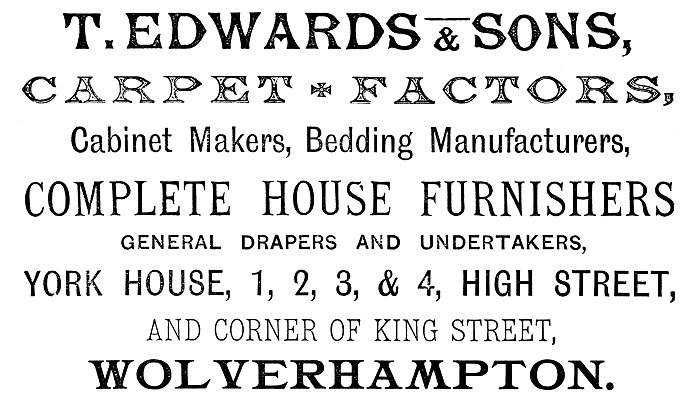
|
 |
|
Return to the
previous page |
|